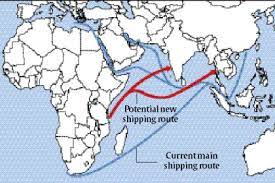Emilian Kavalski: What Next
What Next for the Nearly Decade-Old BRI?
Emilian Kavalski

China encourages its developers to build infrastructure along Arctic routes
When Mr Xi Jinping announced in 2013 the launch of the “Silk Road Economic Belt” and the “21st Century Maritime Silk Road” few would have expected that this would amount to anything more than policy sloganeering of a new leader seeking to establish his foreign policy credentials. Yet, in less than a decade these pronouncements have spawned a diverse and variegated platform for exporting not just Chinese goods, but also Beijing’s influence abroad. Very quickly, these two projects became central to what in Chinese is still labelled as the “One Belt, One Road” (OBOR). Around 2015, the Chinese government decided that the English-language label for the project should be the Belt and Road Initiative (BRI). In hindsight, one might read such change in appellation as the first indication of what Beijing calls today the “double circulation” economy. Regardless of whether one calls it OBOR or BRI, however, the initiative’s core aim of establishing an Afro-Eurasian “community of shared destiny” through large-scale infrastructure projects has remained unchanged. Reasserting this objective, in 2017 China began developing a “Polar Silk Road” exploiting the economic opportunities provided by the opening of the Northern passage as well as buttressing Beijing’s claim as a “near-Arctic state.” Following the outbreak of the Covid-19 pandemic, China launched a “Health Silk Road” channelling the supply of essential medical equipment and vaccines.
Unprecedented in its scale and ambition, the BRI has positioned Beijing at the heart of the shifting global order, through the establishment of China-centric physical, financial, cultural, technological, and political connectivity. As is to be expected such incursion into the established patterns of global interactions has been profoundly polarizing. The COVID-19 outbreak has only made conspicuous how divisive China’s presence has become. To proponents, the BRI offers a viable and meaningful alternative to Western-led international institutions and organizations. With “mutual benefit” as a motto, the Chinese government aims to counter the image of a remote benefactor, associated with Western powers and their modes of foreign direct investment. In fact, the BRI operationalizes China as a veritable model for international leadership and demonstrates the hypocrisy of the so-called “rules-based” liberal world order which has ensured the post-World War II dominance of the Global North. For detractors, the BRI represents just another neo-colonial project ensnaring vulnerable countries around the world in “debt trap” bondage to China. Under the guise of “win-win” scenarios, China is assertively acquiring what it lacks while selling what it has – none of which helps local development. Thus, the BRI becomes just another tool for Beijing’s “wolf warrior diplomacy,” which is assertively staking China’s hegemony over global patterns of economic and political interactions.
Such polarization has ushered in a significant politicization of relations with China in many of the countries along the BRI. Such localization of Chinese investments is probably one of the unexpected effects of the BRI. Thus, while traditional divisions – such as the one between the left and the right of the political spectrum – still pertain, pro- and anti-China sentiments are also emerging as one of the key distinctions between political formations. Another outcome of the BRI has been the unprecedented pushback from major regional and global powers. This has led to a proliferation of alternative connectivity projects countering Chinese investments. For instance, Japan and India are promoting the “Asia-Africa Growth Corridor,” the United States is championing the “Build Back Better World,” while the European Union has launched its own “Global Gateway” initiative. It seems that routing around Beijing is the key characteristic of all such project. While such counteraction is probably to be expected, one of the less palatable effects for Beijing is the growth in negative public opinion. With the exception of Africa, opinion polls around the world demonstrate that despite the largesse of the BRI, China has failed to win friends. It would appear that apart from threats or coercion, Beijing still has little soft power or legitimacy around the world.
Asia Africa Growth Corridor
In this respect, the next 12 months will be critical for the future of the BRI. It is highly unlikely that a Chinese government which is increasingly preoccupied with its own regime stability and perceiving any form of criticism as an existential threat will be able to redress the concerns of the BRI’s detractors. It seems that the BRI is destined to become a much leaner project targeting strategic acquisitions (such as infrastructure hubs, energy, and technology) and rewarding countries (or rather regimes) that have proven to be China’s true all-weather friends. Consequently, the initiative’s “community of shared destiny” will likely become quite exclusive – that is, increasingly open only to those that side with China and its version of the “mutual complementarity” underpinning the BRI.
At the same time, there’s another important takeaway from all of this: The narrative that the world is facing a new Cold War between China and the West needs a reality check. A Cold War needs two powerful protagonists able to act on the global stage. And while China may be growing into an economic, military and technological giant, the “hegemon in the making” is much more vulnerable and isolated than it likes to pretend. Emilian Kavalski is the NAWA Chair Professor of Complex Systems at the Jagiellonian University in Krakow (Poland) and the Book Series Editor for Routledge's "Rethinking Asia and International Relations" series.
Emilian Kavalski is the NAWA Chair Professor of Complex Systems at the Jagiellonian University in Krakow (Poland) and the Book Series Editor for Routledge's "Rethinking Asia and International Relations" series.

